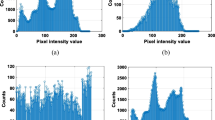Abstract
Watermarking is the process of embedding the particular information into the audio signal for managing the ownership copyrights through wireless network. During the watermarking process, the audio signal consumes high energy, conflicting problem of robustness and imperceptibility, signal to noise ratio, bit error rate and normalized correlation. To overcome these issues present in the audio watermarking process, novel wavelet decomposition and evolutionary algorithm is utilized. Initially the input information or message has been split into two and the spillted message is watermarked using the audio and the image in wireless network. The first half of the message is watermarked with the help of the image and the next half of the image is watermarked by audio. Initially the watermarked image is transferred into YIQ image, from the transferred image the scrambled image is generated with the help of the Hidden Markov tree counter let wavelet transform method for generating the watermarking image. Then the next part of information is watermarked by audio signal which is decomposed into various sub bands using the Multi-resolution complex dual tree wavelet method. From the decomposed audio signal, the message authentication code based watermarks have been embedded in the lower frequency coefficients. Then the embedded process is performed by using the Dead zone quantization process which is optimized with the help of the Fireflies algorithm for enhancing the quality of the watermarking process. Finally both watermarking process is embedded for improving the security to the information with efficient manner through wireless network. In addition the efficient watermarking process through wireless network reduces the various attacks while extracting the water marker. Thus the optimized wavelet and quantization process improves the image and audio watermarking through wireless network and efficiency of the proposed system is evaluated using the experimental results in terms of the Signal to noise ratio, normalized correlation and bit error rate.








Similar content being viewed by others
References
Wu, S., Huang, J., Huang, D., & Shi, Y. Q. (2005). Efficiently self-synchronized audio watermarking for assured audio data transmission. IEEE Transactions on Broadcasting, 51(1), 6976. https://doi.org/10.1109/TBC.2004.838265.
Lee, S. J., & Jung, S. H. (2001). A survey of watermarking techniques applied to multimedia. Proceedings of the IEEE International Symposium on Industrial Electronics, 1, 272–277.
Kumsawat, P., Attakitmongcol, K., & Srikaew, A. (2005). A new approach for optimization in image watermarking by using genetic algorithms. IEEE Transactions on Signalrocessing, 53(12), 4707–4719.
Sriyingyong, N., & Attakitmongcol, K. (2006). Wavelet-based audio watermarking using adaptive tabu search. In Proceedings of the 1st international symposium on wireless pervasive computing, January 2006 (Vol. 1, pp. 15). Phuket, Thailand.
Attakitmongcol, K., Hardin, D. P., & Wilkes, D. M. (2001). Multiwavelet prefilters—Part II: Optimal orthogonal prefilters. IEEE Transactions on Image Processing, 10(10), 1476–1487. https://doi.org/10.1109/83.951534.
Isac, B., & Santhi, V. (2011). A study on digital image and video watermarking schemes using neural networks. International Journal of Computer Applications, 12(9), 1–6.
Tsai, H.-H., & Cheng, S. (2005). Adaptive signal-dependent audio watermarking based on human auditory system and neural networks. Applied, 23(3), 191–206.
Jain, Y. K., & Tiwari, S. (2011). An enhanced digital watermarking for color image using support vector machine. International Journal of Computer Science and Information Technologies, 2(5), 2233–2236.
Peng, H., Wang, J., & Wang, W. (2010). Image watermarking method in multiwavelet domain based on supportvector machines. The Journal of Systems and Software, 83, 1470–1477.
Babyrani, K., & Geetamma, T. (2014). An informed watermarking scheme using hidden Markov model in the wavelet domain. International Journal of Advanced Trends in Computer Science and Engineering, 3(5), 45–48.
Jarwin, M. J. P., & Priyatharsini, S. (2014). An approach using hidden Markov model to design a robust watermarking scheme. IOSR Journal of Electronics and Communication Engineering, 9(3), 29–35.
Mallat, S. G. (1989). A theory for multiresolution signal decomposition: The wavelet representation. IEEE Transactions on Pattern Analysis and Machine Intelligence, 11(7), 674–693.
Akansu, A. N., & Haddad, R. A. Multiresolution signal decomposition. http://www.sciencedirect.com/science/book/9780120471416.
Shoghian, S., & Kouzehgar, M. (2012). A comparison among wolf pack search and four other optimization algorithms. World Academy of Science, Engineering and Technology, 6, 12.
Suresh, A. (2014). An efficient view classification of echocardiogram using morphological operations. Journal of Theoretical and Applied Information Technology (JATIT), 67(3), 732–735.
Goldreich, O. (2001). Foundations of cryptography I: Basic tools. Cambridge: Cambridge University Press. ISBN 978-0-511-54689-1.
Suresh, A. (2016). Sentiment classification using decision tree based feature selection (IJCTA). International Journal of Control Theory and Applications, 09(36), 419–425.
Balgurgi, P. P., & Jagtap, S. K. (2012). Intelligent processing: An approach of audio steganography. In IEEE international conference on communication, information and computing technology (ICCICT), October 19–20, Mumbai, India.
Nehru, G., & Dhar, P. (2012). A detailed look of audio steganography techniques using LSB and genetic algorithm approach. International Journal of Computer Science (IJCSI), 9, 402–406.
Author information
Authors and Affiliations
Corresponding author
Rights and permissions
About this article
Cite this article
Venkatesh, S., Dorairangaswamy, M.A. Implementing Efficient Audio and Image Watermarking Using Multi-resolution Dual Wavelet and Fireflies Approach in Wireless Network. Wireless Pers Commun 102, 2389–2401 (2018). https://doi.org/10.1007/s11277-017-5232-x
Published:
Issue Date:
DOI: https://doi.org/10.1007/s11277-017-5232-x




